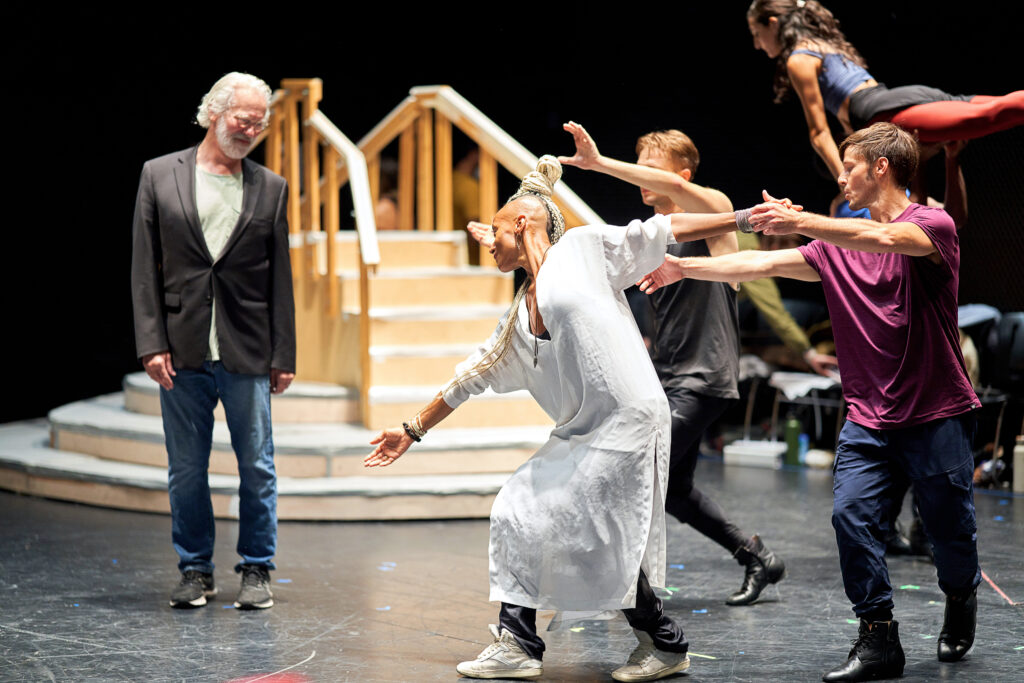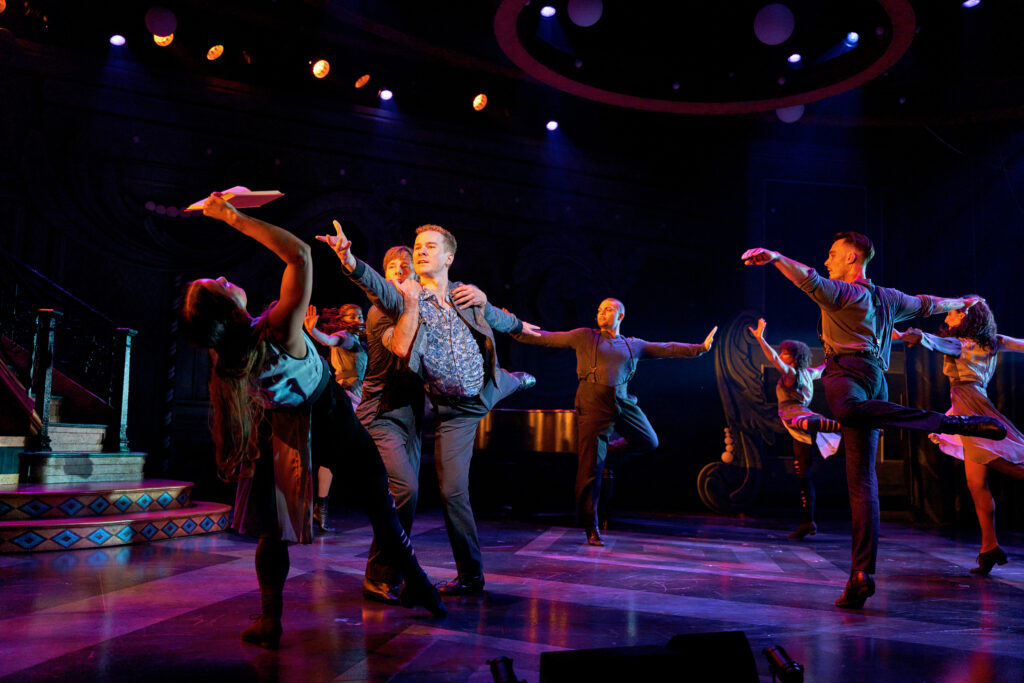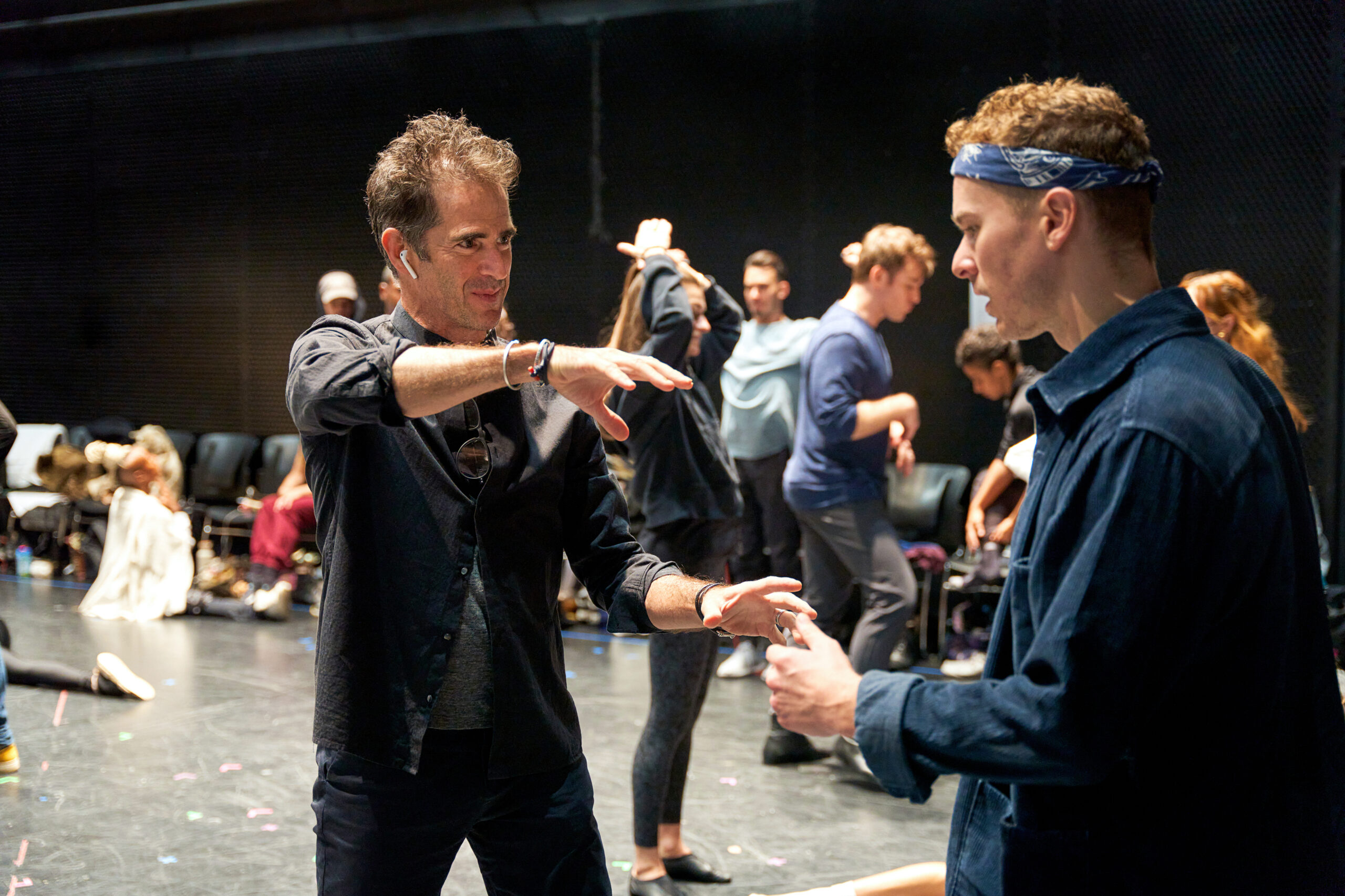Andy Blankenbuehler Opens Up About Only Gold and the Road Ahead
This story begins with a photo of a preposterous necklace, five strands of nearly 3,000 diamonds, one of them the size of a golf ball, alongside a small article about its owner. Some dozen years after seeing it while thumbing through a magazine on an airplane, Andy Blankenbuehler brought a long-cherished project, a stunning dance musical called Only Gold, to off-Broadway’s MCC Theater for a two-month run last fall.
In between, the work grew from an idea into a two-act musical; its main character evolved from a maharaja juggling three wives to a king coping with one; and its author progressed from Broadway newcomer (albeit one with a Tony for In the Heights) to celebrated choreographer (add two Tonys—Hamilton and Bandstand—and other honors, including a Dance Magazine Award). Naturally, just about everyone involved assumed that MCC was step one on the way to Only Gold’s Broadway opening.
I thought so too—I’ve admired Blankenbuehler since the original, unheralded, off-Broadway production of In the Heights, with its Robbins-like flow of totally integrated dance. That’s now his signature, and with Only Gold, he upped his already expert game, weaving dance into every aspect—texture, plot, the very essence of character.
Reporting for Dance Magazine over the years, I’ve watched Blankenbuehler push choreography further and further to the forefront of his musicals, following the path laid by Jerome Robbins, Susan Stroman and Twyla Tharp. He told me about Only Gold some 10 years ago, when he was working with a handful of dancers on choreography for Bring It On, the 2012 show that was his first Broadway musical as a director. He was brimming with excitement about another new piece: Paris in the 1920s! What could be more vibrant? And did I know the work of the British singer-songwriter Kate Nash?

He was a fan, and she’d agreed to let him use her quirky, rhythmic music for a show based on Bhupinder Singh, Maharaja of Patiala, who set 1920s Europe agog when he arrived from India with fabulous wealth, immense charisma, multiple wives and a trunkful of gemstones for Cartier to mount. The eye-popping necklace that resulted, and the sad ending of its owner, who died at 46, inspired Blankenbuehler’s story, about someone who has everything, but nothing that makes him happy.
Shortly before Only Gold closed, he phoned from London—he was on one of his regular working visits to Europe’s Hamiltons—to look back at the show’s “tumultuous life,” and ahead to its unknown future. Because the carping reviews had turned its Broadway ambitions to dust.
“My brain has been upside-down these past few weeks,” he admits. “In some ways the reviews surprised me, and in some ways they didn’t. I know there are tremendous moments—moments I’m extraordinarily proud of. At the same time, I’m aware how the audience is reacting. So I knew that there were still a lot of things that we had to work on—I was game for that.” What he wasn’t ready for was the overall negativity: “Even though a lot said really nice things, they still pointed up the problems more than the pros. So [pause]…that was just a little hard.”
No wonder, given that Blankenbuehler is the musical’s conceiver, co-author (with Ted Malawer), director and choreographer. “Trying to figure out the way a story grasps an audience is difficult,” he says. “I’m really good at it as a choreographer. But when I’m looking at a wider swath, a much wider picture, then it’s a complicated thing. I guess that’s the trouble you get into when you wear a lot of hats.”

It doesn’t help that with seven productions of Hamilton to oversee, that show’s achievements are always in his face. “It’s so good, so well-built, that it just messes you up—it’s really hard to figure out what kind of work to do next. Hamilton is so clean, so efficiently made—that’s one of the things that’s most intimidating. Efficiency is difficult.”
If Only Gold meanders a bit, it’s not because of the choreography. There was general agreement that the dances are superb and the dancers astounding—Tharp favorite Karine Plantadit, “So You Think You Can Dance” sensation Gaby Diaz, West Side Story veteran Ryan Steele, frequent Blankenbuehler collaborator Ryan VanDenBoom. But each of the 13 ensemble members was also a standout. Blankenbuehler himself couldn’t get over them.
“When you make a show,” he says, “you try to get different skill sets. Within an ensemble of, say, five men, one will be a very experienced partner, one does extraordinary things on the floor, one is eccentric and goofy—they do different things. So blocking is really hard. Figuring out who goes where, it’s ‘I have to get him stage right, because he sings this high note and then he has to do this lift.’ It’s a lot of work. But I didn’t have to worry, because they could all do everything.”

Naturally, he gave the ensemble wondrous things to do, which goes back to his experience dancing in Broadway choruses. He loved it, he says, but he longed to be something you can’t be in most Broadway ensembles: an individual. He wanted Only Gold to offer each an opportunity to “step forward” as a specific human being.
They play Parisians in the street when King Belenus (the majestic Terrence Mann) and his entourage arrive from their mythical homeland, and then become servants and jewelers and partygoers as the King, his lonely queen (Plantadit, riveting) and their headstrong daughter (Diaz, dazzling) contend over whom she will marry; the family becomes enmeshed with a talented watchmaker (VanDenBoom) and his musician wife (Hannah Cruz), who struggle with thwarted artistic ambitions. Nash, as the singing Narrator, announces the theme at the outset: “listening to your heart.” But making musicals also means listening to your head.
Blankenbuehler’s initial pitch to Nash was a black-and-white “mini-film” with swirling dancers in berets and such pairing off into flirty, French-flavored duets. When Nash agreed, he began the tinkering that would fill his downtime for the next decade and expand four minutes of dance to evening length.

“For, like, 10 years, it was really just a therapy project, me exercising my impulses,” he says. “When you’re making a new show, you’re problem-solving—not often using impulses that you dream about your whole life. All these years you’re learning this amazing tap rhythm over there, you have this amazing hip-hop class over here—things that create fires in you. But we’re hardly able to employ those things when we’re working.”
Teaching helped. “I was using my classes at Broadway Dance Center, each 45-second combination, as opportunities to experiment. My writing projects became the next step—me writing down the balletic ideas that I had in my head.” When a job came up, he’d stop, resuming after a show opened. “I’d teach a couple of the Only Gold dances in a class, and spend nights working on the script. It was a way to recharge my batteries.”
By 2013, it was ready for a lab, which he used to figure out if Only Gold was a ballet or a musical, and to learn that the songs needed more specificity if it was to be a musical. “And then the piece went away,” he says, “because of Hamilton, Cats, everything.” It stayed gone until 2018, when he did a four-week workshop of it that never got past the first act. But in a tantalizing showing, that first act had gorgeous, impassioned dancing from Seán Martin Hingston as the Maharaja and Alessandra Ferri as his first love, now the senior wife in a household that included Georgina Pazcoguin and Justice Moore as the younger wives. “Again, I continued to learn about it in different ways,” Blankenbuehler says, “and I was actually planning to stay focused on it.” But the Cats movie and the COVID-19 pandemic intervened, “and it really lost momentum,” he says.
In any case, he’d decided that the story needed to be clarified and the number of characters pared down. “The story I wanted to tell actually had nothing to do with polygamy,” he says. “It was about a person who simply had followed everything society and culture had told him would make him content and powerful. And he stopped listening to what would make himself happy.” So the Maharaja gave way to King Belenus and the wise eldest wife to Queen Roksana, while the wild youngest wife became Princess Tooba. The Parisians involved in various subplots remained, and in several cases, so did their casting, with Steele and VanDenBoom reprising their roles from the workshop.

The two months Blankenbuehler spent getting the piece onstage at MCC were the toughest of his career, he says, describing frantic, ridiculously long days and nights that nevertheless left him smiling. “I was so happy because I was getting to do the gutsy work I always wanted to do, but also, I was telling a story about heart. You know me—I have a real life, my family, my wife and my kids, and I want to tell a story that keeps going back to the heart.”
Then the critics arrived. He says he’d stopped reading reviews 12 years ago, but started again after the glowing notices for Hamilton. “That’s not smart; that’s not good,” he maintains. “This time around, I decided to not read the reviews.” But when everyone around him said, “You need to read the reviews,” he relented. Not surprisingly, he’s thought about them in the deep way he thinks about everything.
“The difficulty,” he notes, “is there’s lots of different things to be reviewed. There is emotional impact. There is the idea of using vocabulary in new ways. And the bottom line is people have a hard time talking about dance. So if I’m trying to do something where dance is integral to the storytelling, I have to know that most people who talk about it won’t be able to in a way that really does it justice.” His way of dealing? “You’ve got to take the good with the bad.”
Also, he adds, “I have my own criticism, so I keep working. I keep working until I can’t work anymore.” Even across the Atlantic, he’s pondering “the road map” to making Only Gold successful. “It’s not so much ‘Let’s change this scene.’ It’s bigger ideas, about how the audience should feel as they progress into the story.” And he’s also thinking about what a successful Only Gold would actually mean.

“There’s a line in the show about how you define success,” he says. “So I’m like, ‘Okay, Andy how do you define success?’ You wrote a show that was produced, and people said, ‘These are some of the best dances I’ve ever seen.’ And I also look at them with such pride. That should all be success. Unfortunately, I’m also the maker of the show, so figuring out how to define success is a big deal. For me, success isn’t: You run the show for four weeks and it goes into people’s hearts and minds and dies. It’s gone—that’s not success to me. Success to me is it keeps going.”
To that end, he thinks Only Gold might be perfected with a pickup cast and tour to venues like Sadler’s Wells, following Matthew Bourne’s example. What won’t change is that distinctive mix of music, dance and dialogue that characterizes even dance-driven musicals, though the reviews did prompt some soul-searching. “I went through several weeks of really asking myself questions, like ‘Do I need to forsake this goal of experimenting with this fusion of dance and theater?’ I don’t like dance theater—I like when people talk,” he says.
Still, he says he’s open to working with existing dance companies on new story ballets. “I have to tell a story,” he says. “An idea that has a beginning, a middle and an end.” And there are other limits: “I have to decide how much I’m willing to not dance. My ideas are only getting bigger. But my dancing’s not. I’m still dancing hard, but 10 years from now I’m not gonna be dancing that hard. So my ideas will still be detailed and specific, but my ability to envision that choreography won’t be.”
I remind him that many choreographers work well into their 80s, but he reminds me that they’re basically doing the same type of work year after year. “The difficulty is every show is different from the one before,” he notes. “I’m doing swing dancing one day and cheerleading the next.”
And Paris in the ’20s the next. “Now,” he says, “my job is to be really honest with myself: Can I make Only Gold really a great show? I don’t want to make a good show; I want to make a great show. What’s so interesting with a piece like this is when something works really well, you have to go into surgery saying, ‘Okay, how can I not touch that organ?’ ”
An earlier version of this article appeared on dancemagazine.com on November 23, 2022.




